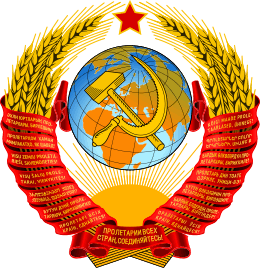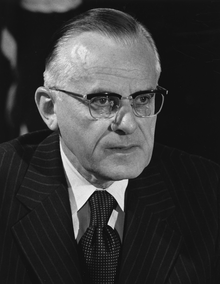Great grain robbery
The great grain robbery was the July 1972 purchase of 10 million short tons (9.1×106 t) of grain (mainly wheat and corn) from the United States by the Soviet Union at subsidized prices, which caused global grain prices to soar. Crop shortfalls in 1971 and 1972 forced the Soviet Union to look abroad for grain, hoping to prevent famine or other crisis. Soviet negotiators worked out a deal to buy grain on credit, but quickly exceeded their credit limit. American negotiators did not realize that both the Soviets and the world grain market had suffered shortfalls, and thus subsidized the purchase. The strategy backfired and intensified the crisis: global food prices rose at least 30%, and grain stockpiles were decimated.
 Soviet emblem, with prominent wheat bunches | |
| Date | July 1972 |
|---|---|
| Location | The Madison |
| Also known as | Russian Wheat Deal |
| Cause | Russian purchases of grain |
| Motive | Lack of grain in USSR |
| Participants | United States and USSR |
| Outcome | Inflation of global grain prices |
Background

Due to the Soviet agricultural system, the cold climate, and frequent irregular droughts, crop failure was common in the Soviet Union.[1][2] Soviet policies had led to disaster before, chiefly the 1932 Holodomor, in which at least five million died of disease and starvation.[3] The problem was heightened by the fact that only a small fraction of the Soviet Union was arable land, the majority of which was contained in an area known as the black earth belt.[4][5] In 1972 there was a drought across Europe. Soviet mismanagement of the situation led to catastrophic wheat crop failure.[6] Additionally, the USSR had suffered an extremely hot summer with temperature comparable to the heat experienced during 2010 Northern Hemisphere heat waves.[7] This caused the Soviet Union to look to the global market to meet their grain needs.[8][9]
Event
The main negotiations for the deal took place on June 20, 1972 at The Madison hotel in Washington, D.C., with two Russian teams, one led by foreign trade minister Nikolai Patolichev and the second led by Nicolai Belousov. The Americans were negotiated for by multiple businessman and government officials.[10] This included Michel Fribourg, the CEO of grain trading firm ContiGroup Companies, and Carroll Brunthaver, the Under Secretary of Agriculture for Farm and Foreign Agricultural Services.[11] The U.S. government negotiated a three-year deal that allowed the Russians to buy U.S. grain on credit. The original deal had the Soviets buying around $750 million worth of grain during a 3-year span.[12] However, the Soviets quickly exceeded their credit limit, spending the $750 million in only one month.[13] The Soviets are thought to have spent up to US$1 billion on grain from companies in the United States and more from other countries such as France, Canada, and Australia.[14]
The U.S. government spent $300 million subsidizing the Russian purchases,[15] still unaware that the Soviets had suffered massive crop shortfalls in 1971 and 1972. American ignorance of the Russian situation was due in part that many officials, such as Earl Butz, were convinced that the Soviets were only purchasing the grain to feed their animals.[16] By not realizing that global wheat stocks were low, and discounting reports of Soviet crop failure, the United States inadvertently contributed to domestic food prices rising, and lost significant revenue by choosing to subsidize the purchase instead of offering it at market price.[17]
Aftermath and international consequences
Weeks after the grain deal was announced, the Earth-observing satellite Landsat 1 achieved orbit. If the satellite had launched a few months earlier, the deal may have been reconsidered or never have happened at all, because American negotiators could have realized the scale of crop failures.[18] The event helped lead the U.S. government to seek more information about global agricultural output via infrared satellite intelligence.[17] After the deal, many Americans were concerned about businesses having advantages in similar situations due to their early access to information.[19] In a ten-month span in 1973, global food prices rose by at least 30 percent and some sources claim up to 50%.[9][20][21][22] In some British markets there was a reported 87% increase on the price of an 800 grams (28 oz) loaf of bread.[23] Global wheat stocks decreased exponentially; Australia was hit the hardest with a 93% decrease by 1974 from 1971.[24] Not all nations were equally hit; some, such as Canada, benefited from the great grain robbery. Canadian farmers had sold their wheat to the Canadian Wheat Board, which were able to pool stocks and sell as a collective.[25]
Contemporary U.S. media referred to the event as "The Russian Wheat Deal" or "The Soviet Wheat Deal".[26][27] The term Great Grain Robbery is a pun referring to the "Great Train Robbery" novel and it is generally accepted that it was coined by Senator Henry M. Jackson.[28]
References
- Golubev, Genady; Dronin, Nikolai (February 2004). "Geography Droughts and Food Problems in Russia (1900–2000)". Center for Environmental Systems Research. Archived from the original on October 11, 2019. Retrieved January 29, 2020.
- "The Great Grain Robbery: Lessons Learned from Earth Imaging's Early History". Earth Imaging Journal: Remote Sensing, Satellite Images, Satellite Imagery. May 18, 2011. Archived from the original on November 10, 2017. Retrieved January 29, 2020.
- Applebaum, Anne (October 13, 2017). "How Stalin Hid Ukraine's Famine From the World". The Atlantic. Archived from the original on December 14, 2019. Retrieved January 29, 2020.
- "Black Earth". novaonline.nvcc.edu. Archived from the original on February 27, 2018. Retrieved January 29, 2020.
- "What Is The Central Black Earth Region Famous For?". WorldAtlas. Retrieved March 26, 2020.
- Schubert, Siegfried; Wang, Hailan; Koster, Randal; Suarez, Max; Groisman, Pavel (December 23, 2013). "Northern Eurasian Heat Waves and Droughts" (PDF). NASA. Retrieved March 13, 2020.
- Grumm, Richard H. (October 2011). "The Central European and Russian Heat Event of July–August 2010". Bulletin of the American Meteorological Society. 92 (10): 1285–1296. doi:10.1175/2011BAMS3174.1. ISSN 0003-0007.
- "Drought of 1972". www.geo.uio.no. Archived from the original on January 29, 2020. Retrieved January 29, 2020.
- "Russia's Wheat Problem Could Be Just The Beginning Of A Global Food Crisis". Business Insider. August 8, 2010. Archived from the original on January 29, 2020. Retrieved January 29, 2020.
- Fialka, John (October 29, 1972). "The Big Soviet Wheat Deal" (PDF). CIA. Archived (PDF) from the original on January 23, 2017. Retrieved January 21, 2020.
- Albright, Joseph (November 25, 1973). "The full story of how Amepиka got burned and the Russians got bread". The New York Times. p. 36. ISSN 0362-4331. Archived from the original on March 30, 2019. Retrieved January 22, 2020.
- Times, Philip Shabecoff Special to The New York (July 9, 1972). "Moscow Agrees to Buy U.s. Grain for $750‐Million". The New York Times. p. 1. ISSN 0362-4331. Retrieved May 22, 2020.
- "America Gets the Shaft". The Harvard Crimson. Archived from the original on December 1, 2016. Retrieved January 21, 2020.
- Jensen, Michael C. (September 29, 1972). "Soviet Grain Deal Is Called a Coup". The New York Times. p. 1. ISSN 0362-4331. Archived from the original on July 12, 2019. Retrieved January 17, 2020.
- Powers, Rachel Chenven (October 29, 2015). "The 'Great Grain Robbery' of 1972". Earthzine. Retrieved January 17, 2020.
- Destler, I. M. (1978). "United States food policy 1972–1976: reconciling domestic and international objectives". International Organization. 32 (3): 617–653. doi:10.1017/S002081830003188X. ISSN 1531-5088.
- "The 'Great Grain Robbery' of 1972". October 28, 2015. Archived from the original on November 1, 2015. Retrieved July 11, 2016.
- "I Spy Thy Rye. Satellites can help gauge crop yields and predict famine, by Dave Levitan". Spectrum.IEEE.org. June 1, 2013. Retrieved June 10, 2019.
- "About the Export Sales Reporting Program | USDA Foreign Agricultural Service". www.fas.usda.gov. Archived from the original on February 26, 2017. Retrieved January 24, 2020.
- Trager, James (1975). The Great Grain Robbery. New York: Ballantine. p. 233. ISBN 0345241509.
- "What Causes Food Prices To Rise? What Can Be Done About It?". U.S. Government of Accountability Office. September 8, 1976. Archived from the original on April 19, 2019. Retrieved March 26, 2020.
- "Food Price Rise at '73 Rate Seen". The New York Times. February 15, 1974. p. 30. ISSN 0362-4331. Retrieved January 17, 2020.
- Smith, Alex Duval (August 7, 2010). "Global wheat crisis recalls Moscow's 'great grain robbery'". The Observer. ISSN 0029-7712. Archived from the original on June 11, 2019. Retrieved January 21, 2020.
- "USDA ERS – Agricultural Commodity Price Spikes in the 1970s and 1990s: Valuable Lessons for Today". www.ers.usda.gov. Archived from the original on December 8, 2019. Retrieved January 17, 2020.
- Larsen, Laura (August 1, 2012). "Repurposing the Great Grain Robbery in Canada" (PDF). University of Saskatchewan. Retrieved January 17, 2020.
- Luttrell, Clifton B. (October 1973), The Russian Wheat Deal – Hindsight vs. Foresight, Reprint No. 81 (PDF), Federal Reserve Bank of St. Louis, archived (PDF) from the original on July 28, 2011, retrieved July 26, 2011
- Alexander, Holmes (September 6, 1974). "Who was the real villain in Russian wheat deal?". Rome News-Tribune. Archived from the original on April 24, 2016. Retrieved July 26, 2011 – via Google News.
- Morgan, Dan (June 10, 1979). "The Shadowy World of Grain Trade". Washington Post. Retrieved January 24, 2020.
Further reading
- Morgan, Dan (1979). Merchants of Grain. New York: Viking.
- "Nation: The Great Wheat Deal". Time Magazine. New York: Time Magazine. October 18, 1963. Retrieved March 11, 2020.
- Robbins, William (May 2, 1987). "News Analysis; Soviet Wheat Deal". The New York Times. New York: New York Times. Retrieved July 26, 2011.
- Staats, Elmer (April 30, 1973). "Examination Into Feed and Related Matters" (PDF). Retrieved March 11, 2020.
- Staats, Elmer (July 9, 1973). "Russian Wheat Sales and Weaknesses in Agriculture's Management of Wheat Export Subsidy Program" (PDF). Retrieved March 11, 2020.
- Staats, Elmer (February 12, 1974). "Exporters' Profits On Sales Of U.S. Wheat To Russia" (PDF). Retrieved March 11, 2020.
- Trager, James (1973). Amber Waves of Grain. New York: Arthur Fields. pp. 243. ISBN 0-525-63010-4.

